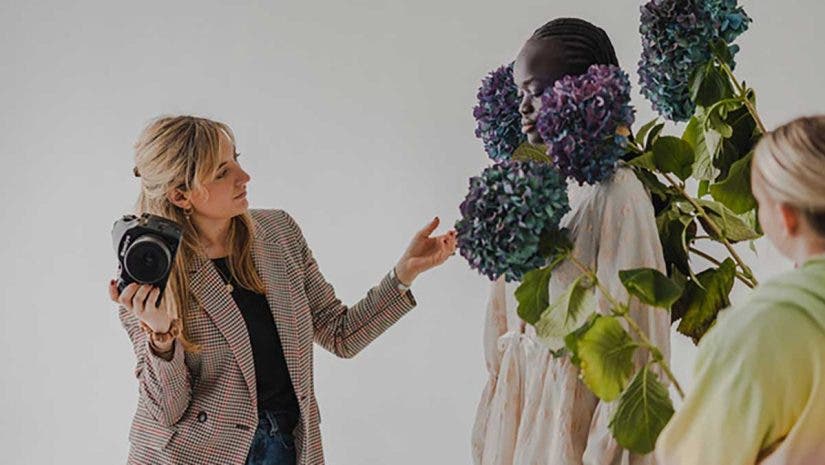If you feel pitching your photography business to brands or media publications sounds intimidating, you’re not alone. The first step in putting yourself out there is learning how to pitch your photography business. While this can feel daunting, not taking this step can hold you and your business back—something accomplished fashion photographer and educator Olivia Bossert knows well.
London-based Bossert watched her career soar after sending that first pitch to a contact at the clothing brand Joules. “They replied within five minutes, which really shocked me,” she says. What started as an initial photography-for-product swap evolved into a successful and paid business strategy. “I use that same model of starting off with a free shoot for a brand; then I go on to get paid work. That’s how I built my portfolio.”
Bossert’s entire career stemmed from that initial outreach. Including work with publications like Elle, Bazaar, and Marie Claire and fashion brands like Manolo Blahnik and Daisy Jewellery. After watching pitching work its magic across her business, she launched courses and a podcast to help aspiring photographers break through those insecurities and create their dream careers.
We sat with Bossert to discuss pitching, coaching, and fashion photography. Here’s her advice on building and pitching your photography business, whether you’re a fashion photographer, a wildlife filmmaker, or any other niche.

Bossert’s Background
Bossert grew up in Switzerland but moved to Cornwall, a coastal town five hours from London, at 18. She studied fashion photography, yet while the rest of her fellow students moved to big cities like London after school, she and her now-husband decided to stay in Cornwall and make her career work.
“It’s a very rural, beautiful part of the UK—like a holiday destination—and I felt inspired there,” she says, noting she initially hatched a plan to work as a wedding photographer—then realized it wasn’t right for her. After that, she sent her first pitch to Joules and discovered that living in this remote location gave her a leg up. Brands would send her products, and she could create shoots with this dreamy coastal backdrop without the company paying a photographer’s travel fees.
She followed this path and made a name for herself, then decided to move part-time to London in 2023. The shift aligns with her growing career goals, including large editorial shoots with fashion magazines. Bossert now splits her time between both areas, allowing her to enjoy two fashion photography settings while simultaneously cultivating her second business pillar: education.

How to Pitch Your Photography
Bossert’s education guides students through multiple facets of photography. Pitching is one of the most popular subjects—and Bossert’s not shy about sharing her strategies for everything from finding email addresses to following up. “Before I started pitching, I’d been playing small,” she says. “I lived in the middle of nowhere and thought I would have to be content with being a little photographer,” she says. “But something in me was like, no, that’s not enough. So that’s where it all sort of escalated. I just kept going back to pitching every week and would send another 15 to 20 emails.”
While that early pitch netted exciting work, she’s received many rejections—and that’s all part of the process. “I don’t take it personally,” she says. “It has nothing to do with you and everything to do with them. I’ve never once had someone tell me to go away. It’s often just ‘no thank you, not right now.'” She recommends taking the rejection and any insights they’ll share on why it’s a no as helpful information.
“It’s OK to feel down about it for a day or two—we’re human,” she says. “But you have to pick yourself up and keep going.”

Misconceptions About Pitching
One thing beginner photographers often worry about when it comes to pitching is whether or not the brand or publication wants to hear from them—or if they’ll come off as spammers. “Pitching is just introducing yourself,” says Bossert. “It’s not pushy, it’s not rude, and it’s not spammy. It’s more like, ‘You didn’t know I existed before, but now you do, and I’m here if you need me.'”
Another misconception about the photography pitch? Silence means no—or something worse. “I always tell people to assume good things rather than think about the worst thing that could happen,” she says. We must remember that the recipients, even those in high-level business positions, are humans at the end of the day. They may have meant to respond to your note but got called into a meeting or had to soothe their crying kid.
Finally, Bossert says it’s essential to focus on sending your photography pitch via email, not social media, to reach the right decision-makers. “A lot of people assume they can rely on Instagram and direct message people, but a lot of the time, Instagram DMs are not monitored by the people who make photography decisions,” she says. “They’re monitored by the social media manager or social media assistant, and they often have no say in [hiring photographers].” She says the only time you should DM is if you’re requesting an email address.

Finding your style
Sending the pitch email is a crucial step. Still, you’ll also want to have a portfolio of work that stands out and shows your style before emailing your dream clients. “Yes, people want an element of what’s trendy, but more than anything, they’re looking for someone who has a unique voice,” says Bossert, noting personal style is a significant part of her online curriculum. “Whenever I go into meetings, they always want to see my personal work; they never want to see the work I did for so-and-so brand because they know that’s not my vision.”
Bossert describes her work as feminine and colorful, and brands often come to her knowing her style whenever they’re seeking this kind of work. She relies on personal projects to achieve this vision, including her current multi-year project that centers on sparkles and sparkly clothing.
While it may seem counter-intuitive to create a personal photography project and then try to pitch it, Bossert says it can open up a new avenue of creative freedom that helps you grow as an artist. “Many painters paint something first, then sell it after,” she says. “They don’t know if they’re going to end up selling it, and it could be a total waste of time—but most of the time, it’s not. I think it’s important to remember we’re artists first and foremost, and we should create stuff that excites us. Isn’t that why we got into this in the first place?”

How can you find your style?
Understanding the need for a personal style is easy. Finding your style can be much more challenging. Bossert’s biggest tip: stop following other photographers on social media, at least temporarily.
“So many of us zone in on the people we love, and we end up subconsciously replicating what they’re creating. We lose what we were originally drawn by and interested in,” she says. “Block out what everyone else is doing, then look internally at what you’re interested in. Use the ideas that come to your head and create work off of that—that’s how you unlock your style.”
You don’t have actually to unfollow all of your favorite photographers. Instead, you can temporarily mute them or—better yet—take a social media detox or break so you can tune into your creativity.
What’s in Bossert’s kit?
Bossert leads everything from small to large shoots; that means she has to be nimble and ready for anything—including a lot of moving around. She keeps her kit as light as possible; it includes a Nikon D-850 camera, various lenses, from the Nikon 50mm to a Nikon 105mm, and the Profoto B10X lights.
Learn more about Bossert’s fashion photography work—including raw, behind-the-scenes accounts of how she builds her business—through her podcast, The Fashion Photography Show, or dive into her courses for a more immersive action plan to advance your creative career.






